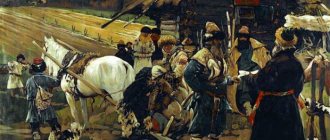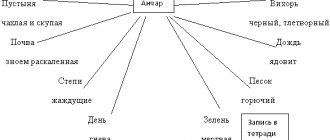History of poetry writing
A. S. Pushkin wrote his “Prophet” in 1826. The poem was dedicated to the uprising and execution of the Decembrists. The poet knew those executed well, was friends with them and considered them the noblest people of his time. He expressed his protest at what happened in the lines of this poem. At this time, he was most concerned with the spiritual aspect of human life.
Lermontov's work is filled with mental pain and bitter experiences. His poem serves as a continuation of Pushkin's. Spiritual continuity is traced between works.
Lermontov created his poem on the eve of his death. It was as if he was predicting his own tragic fate and difficult life path. For a series of poems (“On the Death of a Poet,” “Motherland,” etc.), Lermontov fell into disgrace and was exiled to the front lines of the Caucasian War. The official pretext for exile was a duel with the son of the French ambassador. However, his poems became more and more direct and openly expressed the views of the poet.
The depression and doom that permeate Lermontov’s poems is not only his reaction to disgrace and exile. Such sentiments reigned then among enlightened Russian society. In general, the authors of both works suffered the same fate - misunderstanding of others and early death.
Comparison of the poems “Prophet” by Pushkin and Lermontov
Two poems with the same title “Prophet” were created by two of the most talented poets of the 19th century, A.S. Pushkin and M.Yu. Lermontov with a difference of 15 years. Pushkin composed his “Prophet” in 1826, Lermontov’s “Prophet” was written in 1840 during his Caucasian exile. It should be noted that Lermontov admired Pushkin and dreamed of meeting him. But, highly appreciating Pushkin’s talent, Lermontov made very high demands on himself and believed that his poems were unworthy of being shown to the Genius of Russian poetry.
A comparison of the poems “Prophet” by Pushkin and Lermontov demonstrates their spiritual and thematic relationship.
“The Prophet” by Alexander Pushkin was the poet’s attempt to comprehend his place and purpose in life and in the literary field. On the other hand, Pushkin’s poem serves as a call to his contemporaries - a verb to burn people’s hearts.
The poem was created in the genre of a classical ode. It uses sublime words characteristic of this poetic genre. By this, Pushkin wanted to emphasize that the ode, as a literary genre, should stop serving those in power. This was a challenge to the old literary school, whose followers were Derzhavin, Lomonosov, Karamzin, and partly Zhukovsky.
In Pushkin's "Prophet" the beginning of the theme sounds. The poet shows how a six-winged Seraphim, representing God's messenger in Christianity, flew to his hero in the desert. Seraphim spiritually transformed a man who began to understand the language of animals and birds and hear angels in heaven. This plot is partially taken from the biblical Book of the Prophet Isaiah.
The poem is filled with allegories. By prophet is meant a poet, spiritually reborn, subtly feeling suffering, the beauty of nature, the language of animals. He sees and hears differently from the way ordinary people see and hear.
A comparative description of the poems shows that Lermontov’s “Prophet” serves as a kind of continuation of Pushkin’s theme. Yes, he, the prophet, was filled with the will of God and went to burn the hearts of people. Lermontov seems to show what happened to the prophet years later:
Since the eternal judge gave me the omniscience of a prophet, I read in the eyes of people the Pages of malice and vice.
The biblical theme is also evidenced by numerous Old Church Slavonic words (verb, vizhd, vnemli, right hand and others), the use of which is perceived more logically if we remember that in the 19th century the Bible was published, read and studied in the Old Church Slavonic language.
In his poem, Lermontov shows not only himself, he also talks about what happened to the Prophet - Pushkin, who also had, albeit forcedly, to hide in the “desert” - in his native estate Mikhailovsky.
Lermontov does not deviate from Pushkin’s theme; he shows how thorny the path of all prophets is. But Lermontov’s prophet can only be happy by being alone with himself, talking with the creatures of the earth and the stars. For people, he is an outcast and a laughing stock. People praise and believe those who say what they want to hear. And if a prophet calls for humility and service to God or the Fatherland, then he is a quarrelsome, proud fool. Lermontov's "Prophet" features a biblical theme from the book of Jeremiah. The Prophet Jeremiah was also misunderstood by his contemporaries and was persecuted.
A comparative analysis of the poems by Pushkin and Lermontov “The Prophet” also points to the unity of styles in which both poems were written. Pushkin’s poem is based on biblical style and biblical vocabulary, Lermontov in his “Prophet” adheres to the same theme, Old Church Slavonicisms are also found in his work, although the poem is written in the lyrical genre, and in a simpler language than Pushkin’s “Prophet”.
If we remember that Lermontov’s poem was written shortly before his death, then we can assume that in his Prophet he also showed his thorny path. Lermontov also fell into disgrace after a series of his poems: “To the Death of a Poet,” “Farewell Unwashed Russia,” “Motherland,” etc. In 1840, he was exiled to the Caucasus with orders to send him to the front lines. The reason for this exile was a duel with the son of the French ambassador, and the real reason lay in his freedom-loving poems, which with age and the flourishing of his talent became more and more targeted and directed.
The lack of faith and despondency that permeate Lermontov's poem are associated not only with the persecution of his work, but also with the general mood that reigned in the Russian environment at that time. If Pushkin's Prophet, inspired by the voice of God, comes from the desert to people, then Lermontov's prophet, on the contrary, flees from people into the desert.
Contents of works
In the works of Pushkin and Lermontov, the main characters are endowed with the gift of providence. The prototype of Pushkin's character was the biblical prophet Isaiah, and Lermontov's - Jeremiah:
- Pushkin's hero discovers the highest truth, which he must convey to people. The poet describes the creation of the prophet. The Almighty sends a seraphim to endow the hero with the necessary qualities. The poem reflects the author's belief in the highest justice and the human soul.
- Lermontov's hero, on the contrary, suffers from the fact that people do not believe in the truth that he is trying to convey. He is surrounded by universal contempt. The character's appearance is completely human - he is pale and thin, dressed in rags. The prophet wanders through the city and hears insults addressed to him. He is devoid of hope and does not believe in the future.
main idea
The main idea that can be seen in the poems of both authors is the confrontation between the poet and society. However, Pushkin's character is presented as superior to human vices. The truth is revealed to him in serving people and conveying to them the truth and will of the Creator. From the “dark desert” Pushkin’s hero strives for people. According to the author, for the gift received, the prophet is obliged to serve people and sacrifice his life for them. His goal is to bring light and goodness. This is the main difference between the images of the poet-prophet and the writer.
Lermontov's prophet is the absolute opposite of Pushkin's hero. The poet expresses his views, but does not find understanding among the people around him. In despair, he leaves society for the desert. The poem is filled with despair and hopelessness. The poet feels powerless to convey the truth to people. For his efforts, he is humiliated and persecuted.
The main idea of these poems is the same. Both of them are written as some kind of metaphors. But the authors see the prophetic role of the poet in society differently and describe different aspects of this path:
- Pushkin’s poems describe the process of transforming a poet into a prophet and give the direction to follow.
- Lermontov's poems pay more attention to how difficult and filled with suffering this path is.
main idea
In both poems the prophet is a collective image. He personifies the poet in general. In both works the reader sees: the prophet has knowledge and wants to share it with everyone, but in one of them people reject any aspirations of the genius.
The main idea of A. S. Pushkin is that a poet must, first of all, see and hear. From a sinful and idle man, the prophet became a genius whose purpose was to “burn the hearts of people.” The main thing is to understand the true purpose of art. It was in this poem that A.S. Pushkin established the values and aspirations that apply to any creator and to himself.
The meaning of M. Yu. Lermontov lies in the paradoxical loneliness of the poet in a crowd that fiercely resisted the teaching. The prophet is significantly higher than society in spiritual development: he has an immutable truth, but people do not want to know it, and any talent must be prepared to be ridiculed and expelled. Perhaps the author wrote his “Prophet” as a continuation of Pushkin’s poem. He depicted the further sad fate of the one who “burned the hearts of people with his words”: they simply kicked him out. This version finds its basis in the real life of poets: if A. S. Pushkin was inspired by the revolutionary excitement of the Decembrists, he was confident in a bright future after decisive changes, after an epiphany, then M. Yu. Lermontov was a representative of a generation of disappointed nobles who saw that the uprising came to nothing. Hence the similarities and differences between the “Prophets”: one still believes in the success of enlightenment, the other no longer believes.
Topics and issues
Both poems address similar issues. Main topics covered by the authors:
- The purpose of the poet and poetry is to be prophets chosen by God. Their main purpose is to convey the truth to humanity.
- The problem of the relationship between the poet and the crowd is not revealed in Pushkin, but Lermontov clearly shows it. His prophet is not understood by those around him, humiliated and expelled from society.
In both cases, the poets represent the populace as dark, ignorant and vicious.
Features of the genre and technique
Both great works of Russian poets were created in the same genre - lyrical confession. Pushkin makes his character majestic and significant. To do this, he uses Old Slavonicisms and other techniques to enhance the solemnity of the description. The entire poem is composed in a style close to the classical ode, written in a sublime spirit.
This was Pushkin's hint that poetry in general and odes in particular should not serve only those in power. Previously, odes were dedicated to royalty and written on especially special occasions: birthdays, coronations, etc. In his creation, Pushkin challenges the masters of the old school - Lomonosov, Derzhavin, Karamzin.
The fate of the main character is described sequentially. This technique is called linear composition. However, a ring composition is clearly visible here, in which the description of some events is repeated:
- At the very beginning, a higher power appears to the hero wandering through the desert in the form of a six-winged seraphim. She reveals to him a hitherto unknown truth and transforms him spiritually and physically.
- At the end of the work, the prophet again encounters a higher power - God guides him and dictates his further actions.
The rhyme meter used in both “Prophets” is iambic tetrameter.
A comparison of the lyrical heroes of Pushkin and Lermontov shows that the second character looks more “earthly” and real. The vocabulary of the poem is more modern. It is written in the style of neo-romanticism. Each line is permeated with deep spiritual sadness and the severity of the burden placed on oneself. The genre of the work is lyrical. However, it contains not so much a description of events as a confession of the hero. The reader's experiences and inner world are revealed.
Lermontov also combines linear and circular compositions in his creation. Thanks to the first, the meaning of the verse is easily perceived, the second adds depth and color to it. Lermontov's hero does not meet a higher power directly. However, his prophetic gift is a reference to God's will.
The composition of Lermontov's verse includes:
- The hero's life before solitude with attempts to convey the truth to people.
- Exile and life in the desert.
- Return to the city.
Thus, the poet allows the reader to feel the severity of each of the problems revealed - the poet’s genius as God’s gift, his detachment from the world and his relationship with the crowd.
Genre, size, composition
“The Prophet” by A. S. Pushkin, created in 1826, is a lyric poem by genre definition. At the center of the story is a description of the hero’s inner world and his feelings.
The poetic meter of Pushkin’s “Prophet” is iambic tetrameter. An unstressed syllable is replaced by a stressed syllable with four repetitions - this is the meter chosen by the poet. This criterion of analysis again reveals similarities between Lermontov’s and Pushkin’s “Prophets”: M. Yu. Lermontov also uses iambic tetrameter.
Despite the fact that A.S. Pushkin narrates the fate of the prophet sequentially (linear composition), bright features of a ring composition appear here. First, the hero sees a “six-winged seraphim” who reveals to him a previously unknown truth. By the end of the poem, the traveler again meets with an otherworldly force - God, dictating his will to him. It’s different with M. Yu. Lermontov: the omniscient prophet turns out to be expelled from society. A linear composition promotes ease of perception, while a circular composition adds new meanings. At the same time, although the prophet M. Yu. Lermontov does not meet with God, the text of the poem contains an obvious reference to God's will (thanks to which the lyrical hero became a genius).
The genre of “The Prophet” by M. Yu. Lermontov (1841) (as well as Pushkin’s) is a lyric poem. However, M. Yu. Lermontov gives his “Prophet” the features of a confession. Like A.S. Pushkin, Lermontov’s hero is sensitive, the reader sees his experiences. But the inner world of the exile is revealed more deeply due to the confessional nature of the narrative, due to the monologue of the lyrical hero.
Compositionally, “The Prophet” by M. Yu. Lermontov can be presented as follows. The hero's life before solitude in the desert - loneliness - return to society, to the city. The composition of the poem helps the reader concentrate on the specific problems of each conventional part of the lyrical work (the genius of the poet as a gift descended by God's will, the lack of recognition of the poet and his detachment from the world of people, the relationship between the poet and the crowd).
Means of artistic expression
These tools are used by the authors of both works. The most significant are the following:
- Epithets - they give speech expressiveness and expressiveness (example: wise, flaming, pure, sinful, evil).
- Metaphor is a more generalized technique, transferring meaning according to a similar attribute.
- Personification is the giving of signs of a living being (“the stars are listening”, etc.).
- Comparison.
- Hyperbole is used to emphasize the idea of the prophet being chosen by God, his exceptional role.
- Antithesis - poets contrast love with anger, life with death, etc. This enhances the brightness of the images of the main character and the environment in which he exists.
Pushkin's character is overcome by spiritual thirst. He needs a strong shock to be reborn morally. The meeting with the seraphim is such a shock for him. Now the hero sees the world around him completely differently, which is why his consciousness is radically changing. If earlier his language was “idle and crafty,” now his main task is to burn people’s hearts with words (verbs).
The image of the crowd in Pushkin is practically not drawn. Its existence can only be guessed by the fact that the prophet will touch people's hearts. It is unknown how the poet’s words will be perceived by people who do not know the truth.
The prophet of Pushkin differs from the prophet of Lermontov. The latter already knew the attitude and hostility of the crowd. He was pushed aside and ridiculed by ignorant people. The only ones who understand him are the animals in the desert and the high stars. But the hero does not feel melancholy; he enjoys the silence and harmony of the desert.
The city in Lermontov's poem is described as a center of ignorance. Those living in it do not want to accept truth and knowledge. The crowd throws stones at the prophet.
Images and symbols
A. S. Pushkin “Prophet”:
The prophet is spiritually languishing, he needs a strong shock in order to awaken, to experience something new - to be inspired. The six-winged seraph literally “opened” the hero’s eyes and ears: now he sees the world completely differently, his consciousness has turned upside down. He admits that previously his tongue was “idle talk” and “evil.” From now on, the goal of the lyrical hero is “to burn the hearts of people with a verb.”
The lyrical hero appears in the form of a prophet. It is on his behalf that the story is told and the inner world is revealed. The image of the crowd is drawn very schematically. The reader only guesses that people’s hearts can “light up” from the word of a genius. Whether society will understand him or not is unknown, because the prophet himself, a sinner, left there not knowing the truth, but became spiritually richer after knowing it.
M. Yu. Lermontov “Prophet”:
On the contrary, the genius of the prophet M. Yu. Lermontov remains abandoned and unrecognized. The omniscience of the lyrical hero - here he also turns out to be a prophet - is cruelly rejected by an ignorant society. Indeed, people despise him - he is understood only in the desert, by the stars and animals. The lyrical hero does not feel sad about this; he is happy with his lot. Around him in the desert there is silence and the joy of harmony. Thanks to the confession that M. Yu. Lermontov resorts to in the poem, it is easier to imagine the mental state of the lyrical hero. He is humble, does not experience reciprocal hatred and hostility towards society.
The city becomes the center of a crowd - a gathering of ignoramuses who do not want to accept the fruits of science and open their eyes to the truth. The crowd is cruel: it throws stones at the prophet, it laughs and humiliates him - it drives the hero out of life.






